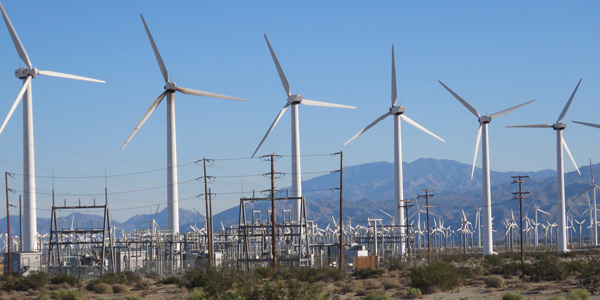By Rich Heidorn Jr.
In a rulemaking reflecting both reliability concerns and the technological advances of renewable generators, FERC on Thursday proposed revising the pro forma Large Generator Interconnection Agreement (LGIA) and Small Generator Interconnection Agreement (SGIA) to require all newly interconnecting facilities to install and enable primary frequency response capability (RM16-6).
The commission said the existing pro forma LGIA may be unduly discriminatory because its primary frequency response requirements apply only to synchronous generating facilities “and do not account for recent technological advancements that have enabled new non-synchronous generating facilities to now have primary frequency response capabilities.”

Wind farm near Palm Springs, Calif. | © RTO Insider
The proposed changes will “ensure fair and consistent treatment for all types of generating facilities, help balancing authorities meet their frequency response obligations pursuant to NERC reliability standard BAL-003-1.1 and help improve reliability during system restoration and islanding situations,” the commission said.
FERC said the rules would not apply to nuclear generators and would not impose “headroom” requirements for new generators. The commission said it would not require that generators be paid for complying with the frequency response requirement.
Declining Frequency Response
Acknowledging concerns over declining frequency response performance, the commission asked for comment on whether the Notice of Proposed Rulemaking is sufficient “to ensure adequate levels of primary frequency response, or whether additional reforms are needed.”
“While the three [contiguous] U.S. interconnections currently exhibit adequate frequency response performance above their interconnection frequency response obligations, there has been a significant decline in the frequency response performance of the Western and Eastern Interconnections,” FERC said.
The commission noted declining frequency response was identified as early as a 1991 study by NERC and the Electric Power Research Institute.
It also cited a 2010 NERC survey of generator owners and operators that found that only 30% of generators in the Eastern Interconnection provided primary frequency response and that only 10% provided sustained primary frequency response. “This suggests that many generators within the interconnection disable or otherwise set their governors or outer-loop controls such that they provide little to no primary frequency response,” the commission said.
“The commission’s pro forma generator interconnection agreements and procedures were developed at a time when traditional synchronous generating facilities with standard governor controls and large rotational inertia were the predominant sources of electricity generation. However, the nation’s resource mix has undergone significant change since” the pro forma rules were issued in 2003 and 2005.
“This transformation has been characterized by the retirement of baseload, synchronous generating facilities and the integration of more distributed generation, demand response and natural gas generating facilities, and the rapid expansion of non-synchronous variable energy resources (VERs) such as wind and solar,” the commission said.
It cited U.S. Energy Information Administration data that the U.S. added 13 GW of wind, 6.2 GW of utility-scale solar photovoltaic and 3.6 GW of distributed solar PV generation in 2014 and 2015. “Conversely, NERC has reported that almost 42 GW of synchronous generating facilities (e.g., coal, nuclear and natural gas) have retired between 2011 and 2014, and the EIA recently reported that nearly 14 GW of coal and 3 GW of natural gas generating facilities retired in 2015.”
The commission said that although wind and solar generators now have the technology to provide primary frequency response, “this functionality has not historically been a standard feature that was included and enabled on non-synchronous generating facilities. Moreover, wind and solar generating facilities typically operate at their maximum operating output, leaving no capacity (or ‘headroom’) to provide primary frequency response during under-frequency conditions.”
RTO Rule Changes
The commission acknowledged it was playing catch up with RTOs that have already begun changing the rules for asynchronous generators:
- ISO-NE and NYISO have adopted provisions to their LGIAs that establish more specific requirements for governor operation.
- PJM has implemented governor requirements for non-nuclear generators and required new non-synchronous generators to have “enhanced inverters” allowing the provision of primary frequency response. (See Enhanced Inverters Clear MRC.)
- MISO requires governor operation as a condition for providing regulating reserves but does not require specific settings.
- The commission recently accepted CAISO Tariff rules on governor settings and provisions for sustained primary frequency response.



